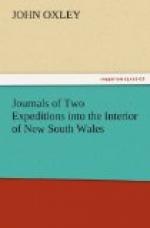September 9.—In the night we had a severe frost, which in the morning was succeeded by a dense fog. We found however that it was confined to the valley, for on ascending the hills, the prospect was clear and open. We passed over a beautiful and well-watered country for about six miles, when we came on the rivulet which we had quitted in the morning; but now, by the addition of several brooks from the valleys, increased to a considerable stream. Its banks were quite clear of timber, and expanded into extensive sheets of water, which added greatly to the beauty of the scenery. This stream running to the east southeast verified the conjecture that we had passed the dividing range of hills, and that this and most probably Sydney River (much superior in magnitude) were coast streams. Crossing the former, we ascended a hill on the opposite side, from whence the river’s course was seen to the south-east, running through a fine and open country. To the northward and north-east the prospect was equally satisfactory, the hills being connected by long and easy slopes, which would have rendered their ascent a matter of little difficulty had our course lain over them. After crossing the river, the country still continued open, but the soil was not so good, and we found that we were ascending in a gradual manner. For the last five miles the country was thickly timbered with stringy bark and gum trees, the soil bad, and crossed by numerous wet hollows, which showed we were nearly on the summit of a level and extensive range of hills. We accomplished fourteen miles with much ease, and halted for the evening in a thick stringy bark forest, where there was worse entertainment for both man and horse than we had experienced for some weeks.
September 10.—A tempestuous morning, with occasional showers of small rain, prevented us from quitting our camp. In the intervals of fair weather, I walked to a hill about one mile off, being the highest part of the range we were upon. Our prospect from it was exceedingly grand and picturesque. The country from north to south-east was broken into perpendicular rocky ridges, and divided longitudinally by deep and apparently impassable glens. The rocks were covered with climbing plants, and the glens abounded with new and beautiful ones. Our collector descended one of those nearest to us, and was amply




